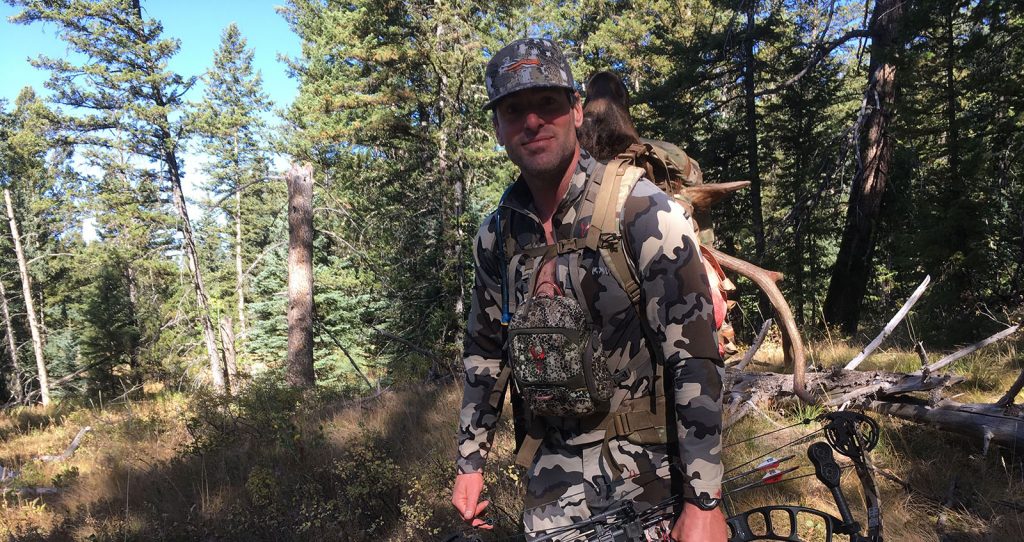
By Rob Shaul
The fitness demands of backcountry hunting include high relative strength (strength per bodyweight), high chassis integrity (functional core strength), work capacity for short, loaded bursts, mountain endurance (running, uphill movement under load), heavy load carriage ability (heavy rucking) and overall physical stamina for long days of movement, or multiple hard days.
What truly separates backcountry big game hunting from backpacking is the off-trail travel, and heavy pack out after the kill.
MTI’s Backcountry Big Game Hunter Fitness Assessment is designed to assess these fitness demands and give the hunter a snapshot of his or her backcountry hunting fitness. Below is the fitness assessment, followed by how it is scored and an explanation of why each event was chosen:
Required Equipment
- Squat Rack with barbell, weight plates, and bench
- 60-pound Sandbag
- 15-18″ Bench or Box for Step Ups
- 3-Mile Flat course for an unloaded run and heavy ruck
- Back Pack with loads of 40-pounds and 90-pounds
- Stop Watch
MTI BACKCOUNTRY BIG GAME HUNTER FITNESS ASSESSMENT
Warm Up:
Weigh yourself on a scale to get current bodyweight, then …
3 Rounds
- 8x Front Squat @ 65/95#
- 8x Hand Release Push Ups
- 8x Walking Lunge
- Instep Stretch
- Lat + Pec Stretch
Assessment:
(1) Work Up to 1RM Front Squat
Protocol: After the warm up, add 10-30 pounds to the barbell and complete 5 Reps. Then add 10-30# to the barbell and do 3 Reps. Based on how the 3 reps felt, add 10-30# to the barbell and start doing single Reps. Keep adding weight as appropriate and doing single reps until you hit your 1RM (1 Repetition Maximum). Record your result.
*** Rest 3 Minutes
(2) Work Up to 1RM Bench Press
Protocol: After the warm up, add 10-30 pounds to the barbell and complete 5 Reps. Then add 10-30# to the barbell and do 3 Reps. Based on how the 3 reps felt, add 10-30# to the barbell and start doing single Reps. Keep adding weight as appropriate and doing single reps until you hit your 1RM (1 Repetition Maximum). Record your result.
*** Rest 3 Minutes
(3) Max Rep Strict Pull Ups
Protocol: No warm up needed. Grip the barbell and complete as many strict pull ups as possible. No time limit. You can rest in the elbows locked out, “down position” but your feet may not touch the ground or a bench while resting, and both hands have to remain on the bar. Record your max reps.
*** Rest 3 Minutes
(4) 10-Minute Sandbag Getup & Run @ 60# for Max Reps
Protocol: Set two cones to 30 feet apart, and a countdown timer or stopwatch for 10 minutes. The athlete starts in the standing position with a sandbag on his/her shoulder at one end. At “go” the athlete lays down, does a sandbag getup, and then runs, with the sandbag to just past the far cone where he/she does another getup and runs back to start. Every length counts as 1 rep (so down/back = 2 reps). Athlete can switch shoulders as he/she sees fit. Record final reps (only full-lengths count).
*** Rest 10 Minutes
(5) Run 3 Miles for Time, Flat Course
Record Finish Time
*** Rest 5 Minutes
(6) 40 Minute Step Ups for Reps @ 40# Backpack
Record Reps
*** Rest 5 Minutes
(7) Ruck 3 Miles for Time @ 90#, Flat Course
Record Finish Time
SCORING
Calculate your Sub Scores for Relative Strength, Work Capacity and Endurance, then add them together to get your Overall Assessment Score
(a) Calculate the Relative Strength Score – Front Squat, Bench Press & Pull Ups
Add together your finishing loads for front squat and bench press.
For pulling strength, multiply your max rep pull up times 7% of your bodyweight.
For example, if you weigh 200 pounds, and get 12 pull ups, you’d multiply 7% of 200 (200 x .07 = 14) and 12.
14×12 = 240.
** Note on Pull Ups … the Max Number you can use for scoring for this assessment is 20. So even if you tested at 25x pull ups, the most you can use for your scoring is 20.
Add your pulling strength total to your other 1RM’s, and divide by your bodyweight. The final number is your score.
Example: Male Athlete who weighs 168 Pounds.
Front Squat – 250
Bench Press – 250
Pull Ups – 16
Pull up Score: 7% bodyweight (11.76) x 16 = 188.16, rounded to nearest .5 = 188.
So ….
250+250 +188 = 688
688 divided by 168 (bodyweight) = 4.09
So this athlete’s Relative Strength Score is 4.09. Plug this value into the chart below to get his assessment subscore, which for this athlete, would be 10.

(b) Calculate the Work Capacity and Endurance Sub Scores using the following Charts
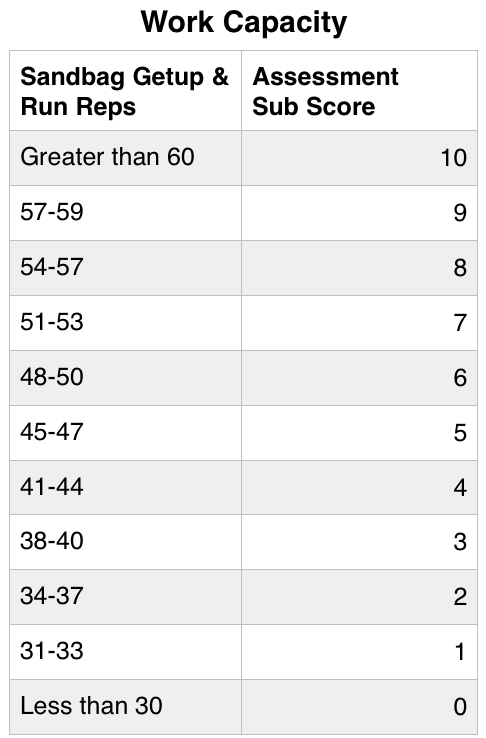
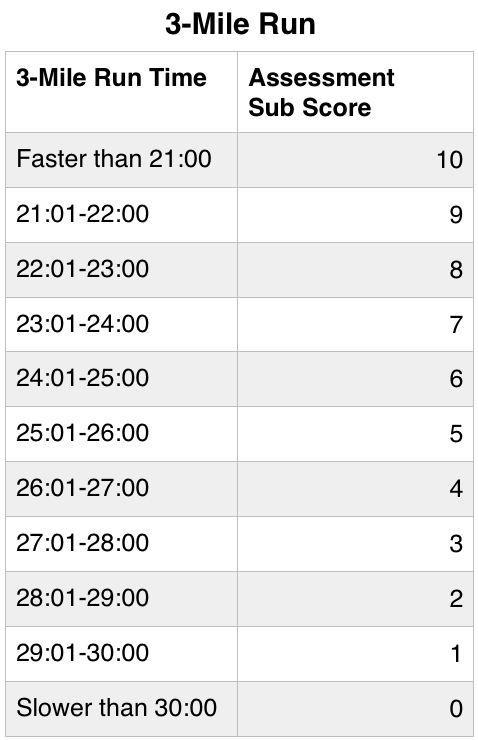

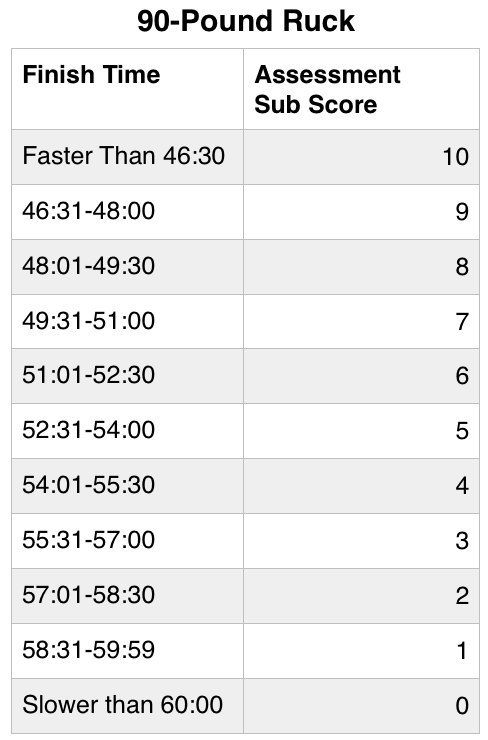
(c) Add your “Sub Assessment” Scores together to get your overall score and placement:
Continuing the Relative Strength example, above, this athlete achieved a 4.09 Relative Strength Score, and a “10” Assessment subscore.
For this example, here were his scores from the other events, the assessment sub-scores, and his overall assessment score:
Event Score: Assessment Sub Score
Relative Strength – 4.01 10
Sandbag Getup & Run – 42 Reps 4
3-Mile Run for Time – 24:39 6
40-Minute Step Up Reps – 633 3
90# Ruck Time – 48:45 8
Overall Assessment Score 29
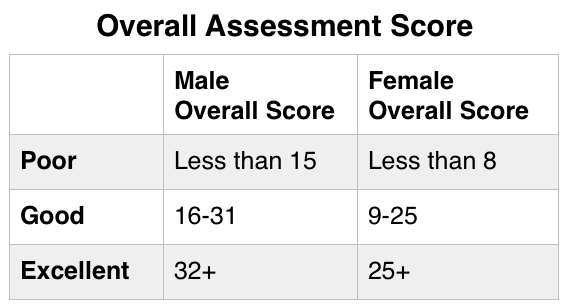
So this athlete would score “Good” on this assessment.
ASSESSMENT NOTES AND EXPLANATION
The broad fitness demands for backcountry hunting include a high relative strength, functional work capacity, and chassis integrity, and mountain endurance (running, uphill hiking under load), and heavy rucking ability. The events in this assessment test each.
Relative Strength
What’s important to mountain athletes and backcountry hunters is their “relative strength” – or strength per bodyweight. The three strength events in this assessment – front squat, bench press and pull ups, are simple, common exercises, which via our calculation, can give us a good snapshot of the athlete’s relative strength.
One of the most interesting things about strength is when an athlete is balanced, his front squat and bench press 1 rep max will be very close together. The same is true for max reps, like this test. With the front squat test, I’m not only testing leg strength, but also strength balance between upper and lower body.
Functional Work Capacity and Chassis Integrity
The 10-minute Sandbag Getup & Run for reps event test both functional work capacity (loaded shuttle sprints) and functional chassis integrity (sandbag get up). This is a no-joke event, which also pre-exhausts the athlete for the coming endurance work, and tests mental fitness and stamina.
Endurance
This fitness assessment tests endurance across three modes – unloaded running, loaded step ups and a heavy ruck. The 3-mile unloaded run tests the athlete’s fast, extended endurance fitness for an extended, fast moving, spot and stalk effort. The loaded step ups test his loaded uphill movement endurance, and the heavy, 3-mile 90-pound ruck test his loaded movement endurance.
As well, there is a reason endurance has a priority in this assessment, as mountain and loaded endurance is the major fitness demand of backcountry big game hunting.
Overall Stamina
All three endurance events, combined, can add up to a 2+ hour effort for slower athletes, and then, added to the earlier strength and work capacity testing, can push this overall assessment to nearly 3 hours. This is by design and is intended to test the overall physical and mental stamina of the athlete.
Questions, Comments, Feedback? Email coach@mtntactical.com
You Might Also Like MTI’s Backcountry Big Game Hunting Packet
